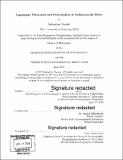Lagrangian dispersion and deformation in submesoscale flows
Author(s)
Essink, Sebastian.
Download1119388671-MIT.pdf (14.98Mb)
Other Contributors
Joint Program in Oceanography/Applied Ocean Science and Engineering.
Massachusetts Institute of Technology. Department of Earth, Atmospheric, and Planetary Sciences.
Woods Hole Oceanographic Institution.
Advisor
Amala Mahadevan.
Terms of use
Metadata
Show full item recordAbstract
Submesoscale currents, with horizontal length scales of 1-20 km, are an important element of upper ocean dynamics. These currents play a crucial role in the horizontal and vertical redistribution of tracers, the cascade of tracer variance to smaller scales, and in linking the mesoscale circulation with the dissipative scales. This thesis investigates submesoscale flows and their properties using Lagrangian trajectories of observed and modeled drifters. We analyze statistics of observed drifter pairs to characterize turbulent dispersion at submeso-scales. Contrary to theoretical expectations, we find that nonlocal velocity gradients associated with mesoscale eddies dominate the separation of drifters even at the kilometer scale. At submeso-scales, we observe energetic motions, such as near-inertial oscillations, that contribute to the energy spectrum but are inefficient at dispersion. Using trajectories in a model of submesoscale turbulence, we find that, if drifters have a vertical separation, vertical shear dominates the dispersion and conceals horizontal dispersion regimes from drifter observations. Particularly in submesoscale flows, vertical shear is orders of magnitude larger than horizontal gradients in velocity. Since conventional drifters in the ocean are not affected by vertical shear, it is likely that drifter-derived diffusivity underestimates the diffusivity that a tracer would experience. Lastly, we test and apply cluster-based methods, using three or more drifters, to estimate the velocity gradient tensor. Since velocity gradients become large at submesoscales, the divergence, strain, and vorticity control the evolution and deformation of clusters of drifters. Observing the velocity gradients using drifters, enables us to further constrain the governing dynamics and decipher submesoscale motions from inertia-gravity waves. These insights provide a Lagrangian perspective on submesoscale flows that illuminates scales that are challenging to observe from other platforms. We reveal observational and theoretical challenges that need to be overcome in future investigations.
Description
Thesis: Ph. D., Joint Program in Oceanography/Applied Ocean Science and Engineering (Massachusetts Institute of Technology, Department of Earth, Atmospheric, and Planetary Sciences; and the Woods Hole Oceanographic Institution), 2019 Cataloged from PDF version of thesis. "The pagination in this thesis reflects how it was delivered to the Institute Archives and Special Collections. TOC pagination for Bibliography section is off by one page"--Disclaimer Notice page. Includes bibliographical references (pages 115-123).
Date issued
2019Department
Joint Program in Oceanography/Applied Ocean Science and Engineering; Massachusetts Institute of Technology. Department of Earth, Atmospheric, and Planetary Sciences; Woods Hole Oceanographic InstitutionPublisher
Massachusetts Institute of Technology
Keywords
Joint Program in Oceanography/Applied Ocean Science and Engineering., Earth, Atmospheric, and Planetary Sciences., Woods Hole Oceanographic Institution.